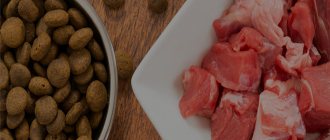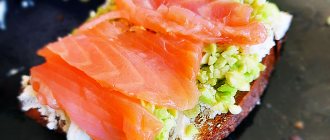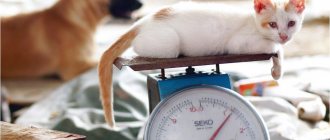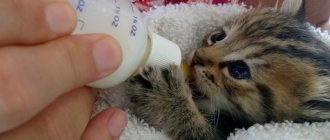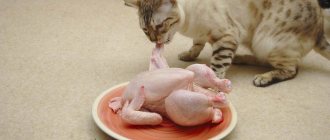Should I give my cat boiled or raw meat*? This is one of the most important issues when creating a so-called “natural” diet for your pet. And both options have their pros and cons, which we will discuss in this article.
Can cats eat raw meat?
The answer is clear: it is possible and necessary. It is obvious that for domestic cats living on the street, like their wild counterparts, no one prepares food for them; they consume rodents, mice and birds raw. At the same time, unlike many predators, they eat them immediately and mostly whole, without leaving the prey to decompose for more efficient absorption.
The cat's gastrointestinal tract is naturally designed to consume raw meat. The high acidity of gastric juice allows you to destroy pathogens contained in the carcass and dissolve raw bones. And the enzymes produced by the pancreas and other digestive organs, like the bacteria in the cat’s intestines, are adapted for the digestion of raw meat.
However, owners should understand that there is still a difference between a domestic cat living indoors and a wild or outdoor cat. So the acidity of the stomach, the composition and amount of bacteria and enzymes, directly depends on what the animal eats. If a cat has been eating industrial food for a long time, then it will be difficult for its body to digest raw meat and destroy the pathogenic organisms in it, many of which are dangerous not only for the cat, but also for humans.
Of course, a cat can be gradually transferred to raw meat, but such a transfer is not always necessary. You should not experiment if the cat is younger than 6 months/over 7 years old or if it has chronic diseases, especially those related to digestion. Most importantly, remember that the perfect is the enemy of the good. Does your cat thrive without raw meat? So there is no need to change anything.
Types of “safe” meat for cats
More than 80% of a cat's daily diet is meat. But, before feeding your mustachioed pet this product, you need to figure out which types of meat will be beneficial for the cat’s health and which types of this product can cause serious harm to the body.
First of all, you should focus on the following rules:
- the meat must be fresh;
- low-fat;
- without small and dangerous bones;
- no unpleasant odor.
You need to feed your cat high-quality meat, and not waste product that is not useful on the human table. From time to time, your pet can be pampered with offal and cartilage, always fresh and low-fat (no more than 200g per week).
To feed your cat, you can buy chicken, quail, lean lamb, beef, rabbit, turkey, horse, goat and beef.
Pork, duck, goose and fatty lamb are prohibited.
Now let's figure out in what form meat can be served to a domestic cat.
Grilled meat
Fried product is strictly prohibited for feeding domestic cats. After eating such meat, the animal may experience serious problems with the liver, stomach and other organs of the digestive tract. All this will lead to a lot of unpleasant health problems for the pet and will significantly shorten its lifespan.
Cooked meat
This meat can be given to a cat. It contains many nutrients that are beneficial for her body. The main thing is to cook the meat correctly: boil it in low-fat broth without salt and other spices.
And one more rule: you cannot give raw and cooked meat at the same time. To digest these foods, the body will need to produce different enzymes, which will negatively affect the digestion process. This may manifest itself as vomiting, stool disturbances and other unfavorable symptoms.
Chicken for kittens as a first food
If you have a question: “Is it possible to give chicken to kittens as a first food?”, then the answer is: - Yes! At 3–4 weeks of life, when the pet has already grown up and its digestive system has adapted to mother’s milk, the first complementary foods are introduced.
For this purpose, fresh chicken meat is used because of its lightness and quick digestibility. Bones, veins and fat accumulations are removed. From 5–6 weeks, boiled beef, pork, vegetables, cereals, dairy and other products are added to the diet. This is necessary to expand the diet and make it more complete.
Mixed nutrition
There are three types of diet for domestic cats:
- natural nutrition from ordinary products familiar to humans;
- feeding with ready-made industrial feed created for animals;
- mixed diet, which involves feeding cats natural products in combination with ready-made food.
Natural food and raw meat
When feeding natural food, the issue with raw meat is resolved on its own. This product is included in the pet menu. It can be served in processed form. To get a more nutritious meal, veterinarians recommend combining meat pieces with other healthy foods.
Dry, wet food and raw meat
Is it necessary to feed a cat raw meat if it regularly eats ready-made industrial food?
Chicken for kittens as a permanent food
To the question “Is it possible to feed chicken meat to kittens all the time?” Experts give mixed answers. But they adhere to the fact that in the first three months of life the diet should remain unchanged. Other products are added gradually and in small portions, but chicken meat must be present. You can replace it when the kitten grows up and adapts to heavier products.
Boiled or raw chicken meat is good for kittens for complete nutrition. It is cheap, accessible and easy to digest. If you follow all the rules, your pet will be happy with this dish and will grow up healthy and happy.
Content:
What pathologies does raw meat contain?
The biggest risk to a cat from raw meat is the possibility of helminth infection. These parasites not only significantly worsen the general condition of the animal, but can also cause death.
To protect your cat from such risks, properly prepare fresh meat for feeding your pet! Buy this product only from trusted places, carefully checking it for freshness.
Be sure to freeze the meat before serving and heat treat it. For preventative purposes, periodically give your pet anti-helminth medications. An experienced veterinarian will tell you which drug is best to choose.
Boiled or raw?
During the heat treatment of chicken meat, many processes occur: the product becomes softer, not only its taste, color, consistency changes, but even its nutritional value, this makes you wonder, is it possible to feed a cat boiled chicken?
When meat is heated, proteins change their structure - they denature, including the protein myoglobin, which is responsible for the red color of meat, so it becomes gray. The muscle fibers contract, become denser, and fluid with dissolved substances comes out of them. When heated for a long time, collagen turns into glutin and also dissolves, which leads to softening of the meat. Fats also melt and partially go into the broth. Many vitamins decompose during cooking, especially B vitamins.
At the same time, the amino acid composition of proteins does not change, and therefore boiled chicken meat for kittens and cats remains a complete source of animal protein. Nothing happens to microelements unless you cook the chicken for several hours in a large amount of water, otherwise they will all end up in the broth.
Meat for castrated and sterilized
As you know, it is very important for cats after sterilization and cats after castration to choose the right diet for feeding. After such operations, great changes occur in the animal’s body, metabolic processes slow down. With improper feeding, there is a high probability of developing certain diseases that significantly worsen the general condition of domestic cats.
After sterilization, cats can be given lean meat, but only in raw and frozen form! The boiled product is not particularly beneficial for the body of operated animals. In addition, boiled meat can provoke protein intoxication, a very dangerous condition for cats.
Portions must be dosed and served fresh. You can also add some types of offal in small quantities to the menu.
After castration, cats can also eat raw lean meat after preliminary freezing. Fractional meals in small portions are encouraged, up to 5-6 times a day.
The cat should not be given a supplement, even if he really asks for it. The restless appetite of a castrated animal often leads to obesity, as a result of which the cat develops other unpleasant health problems.
Proper feeding of cats
Are you feeding your pet correctly?
NATURAL NUTRITION
- Raw frozen beef – (for a kitten at least 30 grams, for an adult cat – 100-120 grams).
 Every day (from about 3.5 months to 500-1500 grams of beef per day).
Every day (from about 3.5 months to 500-1500 grams of beef per day). - Boiled chicken without bones - you can have it every day. Chicken breasts for kittens. From about 3.5 months you can give chicken legs.
- Chicken or beef by-products (heart, lungs, liver, kidneys) (frozen) in boiled form. Heart no more than once a week (boiled). Boiled liver (since the liver is a filter for any organism, including ungulates) - do not get carried away with light-colored cats, the fur may turn brown or yellow. Lungs and kidneys are optional; few cats eat them at all. All frozen meat products must be scalded with boiling water.
- It’s better not to give fish at all.
- Chicken egg yolk (whites should not be given) - raw or boiled in pure form or can be ground with cottage cheese. 1-2 times a week. Quail eggs can be given whole raw.
- Milk is fresh, raw or boiled (only for kittens under 3 months of age, since an adult cat cannot digest milk and causes an upset stomach, but a kitten needs it).
- Liquid milk porridge (for kittens under 3 months of age): sometimes oatmeal is given, a small amount with the natural method of feeding, but this can be omitted; it is better to replace it with vegetables.
- Fermented milk products: kefir (it’s good for kittens to add gluconate and glycerophosphate, ground into powder), bio-yogurt, cream (a little) - all of medium fat content, as well as cheese. You can do it every day. Cheese is given to older kittens (4-5 months), often as a reward or treat during training.
- Fresh non-acidic cottage cheese (also with the addition of gluconate and glycerophosphate, ground into powder) - can be mixed with sour cream or raw egg yolk. Kittens – 3-4 times a week, adult cats – 1-2 times a week.
- Cereals: oatmeal (steamed), rice, buckwheat – mixed in a 1:2 ratio with boiled meat (1 cereal: 2 meat). Few times a week.
- Raw or boiled vegetables: carrots, cauliflower, dried seaweed, pumpkin, tomatoes, cucumbers (a little), any fruits, etc. - mixed in a 1:2 ratio with meat (1 vegetables: 2 meat). Several times a week (alternate with cereals).
- Greens – sprouted wheat grains. You can grow grass on the windowsill (from wheat or oats). NO grass from the street! There is no need to add it to food, because... The cat regurgitates grass. Older kittens are given a hair removal paste (for example 8in1).
- Dry brewer's yeast - found in all complex supplements (B vitamins). A daily kit + microelements + supplements is provided.
- Cats are not given vegetable oil, only Vaseline, if there are problems such as constipation. You can take a drop of ADE oil vitamins into your mouth daily. With normal nutrition, kittens should not be constipated.
- Mineral and vitamin supplements (for example, Canine vitamins, 8in1). Every day, dosage depends on the age of the kitten. The rest is a delicacy. Real vitamins are packaged in powders and injections.
- Fresh water, purified through a filter or boiled, should ALWAYS stand. Do not accustom cats to boiled water, then if they drink raw water from the tap, they will have stomach problems. No need to raise a hothouse frail animal!
Cat food is not salted, sweetened, or seasoned.
Meat and meat by-products that are given raw must first be frozen in the freezer and then scalded before feeding. You cannot feed your kitten only meat and fish, or only cereals. You shouldn’t get carried away with fish at all; its excessive consumption leads to inflammatory kidney diseases and urolithiasis. Castrated animals should not be given fish at all.
Food should be slightly warm or at room temperature. Do not give food that is too hot or cold (from the refrigerator). All food for the kitten is ground very finely, large and small bones are carefully removed. For an adult cat, food is cut into small pieces. Don't give big pieces! It is better to immediately teach the cat to eat in only one place (this should be a quiet, calm place, not in a draft, where no one walks constantly, not near the door, as you can accidentally hit the kitten).
Raw meat is given in its pure form (you can also add raw carrots with a drop of clarified oil), boiled meat should be mixed with vegetables to avoid constipation.
Kitten 1.5-2 months. fed approximately 5 times a day (or given free access to food). By six months, gradually reduce the number of feedings to 3 times a day. From 8 months Feed like an adult cat 2 times a day. In general, it is difficult to reduce feeding a cat to one meal at a time, since cats eat several times. If you want a well-fed, growing animal, there is no need to restrict food: cats do not overeat if they do not have health problems.
Remember: a cat is a carnivore, and it does not have to eat borscht, pasta or coleslaw. A cat has its own special diet, and you should take this into account when feeding your pet, and not try to accustom it to what you and I eat - this is HARMFUL for cats and leads to various diseases.
NO CATS! (any age)
- Chicken and fish bones - A kitten or cat can choke, and bones damage the esophagus and stomach and clog the intestines.
- Pork. Poultry meat (except chicken and turkey): goose, duck. In its raw form it leads to infection with worms, in some cases to dangerous infectious diseases, which leads to the death of the animal. This meat is very fatty and is poorly absorbed by the cat’s body.
- Fatty, spicy, salty, smoked foods, incl. sausages and canned food for people. Fried foods. They cause gastrointestinal upset and disrupt metabolism. As a result, the animal looks bad and chronic diseases appear.
- Sugar, chocolate, candies, cakes and everything sweet. Disturbs metabolism, weak immunity, dull coat, dental diseases. CHOCOLATE contains theobromine, which is a POISON for cats and causes severe poisoning and death of the animal.
- Potato. Starch is not digested by the cat's intestines; potatoes are absolutely useless for her and can cause upset.
- Legumes (soybeans, peas, beans). It is not absorbed by the body and causes bloating and fermentation in the intestines.
- Salt, spices. Food for cats is not salted or spices are used, because... This does not bring any benefit to her body, only harm.
- Medicines, incl. vitamins intended for humans. Cats have their own special balance of substances in their body; vitamins for humans are not suitable for them. In addition, many medications for humans cause severe poisoning; the kidneys may fail, which leads to death. For example, a weakened cat can be killed with a no-shpa tablet.
READY (INDUSTRIAL) FEED
Feeding with prepared food is more convenient, because... allows you to save time on cooking, it is balanced, and the cat receives all the necessary nutrients.
You can feed dry and canned (canned) food (adult animals only!).
You need to choose high-quality dry food from good manufacturers: Eukanuba, Hills, Nutro, Eagle Pack, Purina Pro Plan. Cheaper food Iams (Yams), Royal Canin (Royal Canin). Good foods are usually labeled "Premium" or "Superpremium".
Cheap food like Kitty Kat, Katinka cannot be given! The same applies to widely advertised foods such as Whiskas, Friskas, etc. They are of poor quality, contain too many mineral salts, and do not use meat and high-quality offal as protein, but bones, skins, and feathers. Their consumption leads to various diseases and does not satisfy the cat's needs. There is also a high risk of developing urolithiasis.
Among canned food, good food comes from the dry food manufacturers recommended above, as well as Gourmet and Petrit treats (“canned natural food”).
A kitten up to 8-10 months, sometimes up to a year, is fed with special food for kittens, both dry and canned. This is very important for proper development. Then they are transferred to adult food. Kitten food is also given to pregnant and lactating cats. When feeding dry food to a male cat (especially a neutered one), the packaging should be marked “prevention of urolithiasis” (this food has a special formula with a low content of ash, phosphorus and magnesium). For a cat this is not so important, just high-quality food is enough. Dry food can be poured throughout the day, it does not spoil. Canned food provides as much as the animal can eat at one time. The following diet is recommended (based on the daily dose): 75% canned food, 25% dry food - for show animals, for others - 50x50.
IT IS NOT RECOMMENDED TO MIX READY-MADE FEED FROM DIFFERENT MANUFACTURERS, SINCE EACH COMPANY DEVELOPS ITS OWN DIET (SET OF PRODUCTS, VITAMINS, MINERALS). IF THE FOOD IS MIXED, THEN THERE IS NO NEED TO TALK ABOUT BALANCED NUTRITION.
Irina Mukhina
Is it possible to give raw meat to small kittens?
It is possible and even necessary to feed a small kitten raw meat! This product is especially useful not only for the body of a maturing predator, but also for its milk teeth. The first meat food can be introduced into the cat’s diet starting from 2 months of life.
For greater benefit, it is recommended to give the meat to the kitten with a bone, in the process of gnawing which, beneficial massaging of the gums and teeth occurs. Such prevention reduces the likelihood of developing tartar in animals.
The bones should not be small in size. It is unacceptable to give your kitten chicken and fish bones. They are dangerous for animals, as they can injure the esophagus and other organs of the digestive tract.
Also, you should not give your cat boiled bones, which are softer in structure. This product can also cause gastrointestinal problems.
What kind of meat can you feed a kitten? Fresh, low-fat and processed! This product is best served in small pieces. To complete your diet, mix meat with healthy cereals and vegetable purees.
What to do?
If you want to feed your cat chicken, go ahead! But in our realities, it is better to feed her boiled chicken so that she does not become infected with salmonellosis or any other dangerous bacteria. When cooking, some vitamins, of course, will be destroyed, but the cat will be able to replenish them with other food (that is, the cat cannot be fed only chicken - its diet should be as varied as possible ).
Remember that salmonella in meat dies in 10 minutes at a temperature of 75 degrees . That is, cook the chicken, chicken hearts and chicken livers longer, and don’t just scald them with boiling water.
What will a cat choose: boiled or raw chicken?
How often to feed meat, and in what quantity?
Meat is the most important product in the diet of a domestic carnivore. It must be given to the cat every day. According to generally accepted standards, 80-90% of a pet’s daily diet is meat.
The amount of product to feed is calculated individually, depending on the age of the cat and its activity.
On average, kittens need 30g of meat per day, adults – about 100g. If the cat is overly active and spends a lot of time playing outdoor games, you can slightly increase the dosage of this product.
But, in order not to harm your pet’s health, we still recommend that you first consult with a veterinarian, who can accurately determine the norm for feeding your cat with meat products, taking into account its age, weight and activity level.
And remember, proper feeding is the key to a long and happy life for a domestic cat in your friendly family!
How to give: the best recipes
Cat owners recommend preparing the following simple chicken dishes for natural-fed pets:
- Chicken with vegetables. The breast is boiled and chopped. Add steamed broccoli and carrots in equal proportions. Then a small amount of fresh broth is introduced.
- Liver with garnish. Finely boil and chop 400 g of offal with the addition of 2 tbsp. l. olive or sunflower oil. Add 200 g of steamed oatmeal and 50 g of steamed green peas.
- Kidneys in sauce. Boil and chop 200 g of chicken kidneys. Add 4 tbsp. l. prepared oatmeal and ¼ cup grated carrots. Melted butter of medium fat content - 30 g is poured on top. Then 70 ml of yogurt without additives is added.
- Nutritious breakfast. Boil 70 g of rice. It is better to use unrefined, as it improves intestinal motility. Combine 1 boiled chicken egg in one plate, 1 tbsp. l. chopped carrots and boiled green beans and 20 g of chopped chicken fillet. 3 tsp is introduced. olive fruit oils.
If your cat previously ate exclusively dry food, raw chicken may not be of interest to her. Veterinarians advise boiling it and adding treats that your pet loves.
For babies and older cats, veterinarians recommend placing cooked food in a blender to facilitate digestion and prevent constipation. It is not enough for cats to eat meat in its pure form; the menu must be supplemented with sources of carbohydrates and fiber - bran, vegetables or fruits.
Cats are predatory creatures by nature. In nature, they consume mainly protein, and only a minimal percentage of carbohydrates and fats. Regular cats need twice as much meat as other animals. Therefore, their body is aimed at processing protein, not carbohydrates, and receives the necessary energy from this.
In order to prevent exhaustion and disease of cats, their daily diet should contain not only protein, but also amino acids and vitamins. All of the above elements combine well in chicken meat. However, thermally untreated chicken, despite retaining all the vitamins and important properties, carries various diseases for the “fluffy”. Is it possible to give a cat boiled chicken or still switch him to store-bought ready-made delicacies? We'll figure this out now!
Pros and cons of natural feeding
In fact, I didn’t find many advantages for myself in this type of cat food.
Pros:
- It's not very expensive. You do not overpay for ready-made food, you have the opportunity to choose the optimal price and quality. You can buy a whole chicken, boil it and feed it to your cat. It works out economically.
- You can be confident in the quality of the prepared food. Since you chose the products yourself and prepared them yourself, you are sure that the food is absolutely natural and healthy.
However, this type of food has more disadvantages:
- Time costs. Each time the preparation takes several hours.
- It is very difficult to perfectly balance the diet in terms of dietary supplements and vitamins and minerals. Naturally fed cats most often have a deficiency or excess of certain substances in the body. If your cat's fur is dull, not shiny, greasy or falls out excessively, it is likely that the cat's natural diet is not balanced. My cat sometimes had problems with fur on natural food and never on factory food.
- It is necessary to buy vitamin and mineral supplements. High-quality vitamins and minerals, if given to your cat frequently, are not very cheap. In addition, not all vitamins are eaten by cats on their own and you need to spend extra time giving vitamins to your pets.
- Waste of freezer space. 30 jars of food takes up a lot of space. Not everyone has such large freezers or freezers.
- Some capricious cats may refuse natural food. And in the case of an allergy to chicken, you will have to switch to more expensive beef.
Of course, you don’t have to bother and buy baby food for cats in jars. It (for the little ones) does not contain salt, but it contains meat and healthy vegetables.
But, firstly, 2-3 jars of baby food a day are expensive. 150 rubles a day for a cat is a high amount, the costs are unreasonable. Secondly, all baby food is puree. A young animal should still eat meat in pieces, and not constantly eat pureed food.
How to read labels: what should be in the food
Ingredients are usually listed by weight on the label. For example, in wet food, beef, fish, chicken and turkey will be at the top of the list, but in dry food they may be at the very end due to the excess moisture being removed from them. Experts warn that the packaging may not contain complete information. If in doubt, it is better to consult a doctor or go to the manufacturer’s website and contact support.
How to read the label:
First step
- look at the name and compare with the composition. It should consist of 35–95%, not counting water, of the product stated in the name. For example, if it is rabbit food, then the main ingredient should be rabbit meat.
Second step
— check the entire list of components.
Cats are descendants of semi-desert carnivores, so they need a lot of protein, a moderate amount of fat and a minimum of carbohydrates. And also vitamins, minerals, fatty acids and amino acids. Therefore, check that the composition contains animal protein - cats need taurine and Omega-6 arachidonic acid, which are found only in animal and poultry meat or offal. These elements cannot be obtained from plant foods, so vegetarianism is contraindicated for cats.
Useful and harmful components in cat food
- Protein - beef, chicken, turkey, rabbit - at least 35%.
- Fiber - oats, wheat, rice, and carbohydrates - no more than 25%, otherwise the cat may have an upset stomach.
- By-products - at least 30% of the composition.
- Vitamins and mineral supplements: taurine, Omega-6 arachidonic acid, calcium, vitamin A, E, K, B vitamins, ascorbic acid, zinc, copper, amino acids. Vitamin D is essential for kittens.
- Dye E127 can provoke cancer.
- Oxidizing agents E320 and E321 can damage the liver, cause seizures and neuroses.
- Waste - skin, cartilage, feathers, horns, beaks, hooves. If a specific protein source is not indicated on the packaging, the manufacturer may be hiding the fact that the food is made from waste.
Veterinarian Ivan Ryzhov notes that food containing chicken should be given to pets with caution. This is a strong allergen, the effect of which does not appear immediately. Therefore, if your cat has itching or dull fur, check the composition and consult a doctor.
Are by-products healthy?
Many owners avoid them because I think that waste - horns, hooves, skin, beaks - also falls into this category. But by-products are internal organs, such as liver, kidneys, lungs, heart. They are healthy, nutritious and easily digestible by the cat's body. The food packaging must list the specific by-products that it contains.
The healthiest meat
To keep your furry pet healthy, it is recommended to feed it raw meat. It has a number of useful properties:
- has all the amino acids and proteins necessary for the body to function properly;
- ensures the functioning of internal organs;
- easily digested in the stomach;
- the cat is less likely to get gastrointestinal diseases.
Fried or smoked meat is not allowed. These products can irritate the digestive system and cause severe gastrointestinal diseases. Substances contained in fried foods and smoked foods contribute to the occurrence of liver pathology. If a cat suffers from a “weakness” of the pancreas, then due to poor quality food, diseases of this organ may appear.
Cold meat just taken out of the freezer can make your pet sick. It is better if it is at room temperature - the risk of colds will be reduced to zero.
Precautions and possible harm
The main danger of feeding raw beef to animals is the likelihood of harmful microbes and helminth larvae entering their bodies. The most common types of parasites are:
- Campylobacter, which causes intestinal upset;
- salmonella, which causes diarrhea and vomiting;
- Brucella, which affects many internal organs and cannot be completely cured;
- false rabies virus, which brings the cat to convulsions and paralysis;
- Escherichia coli, dangerous due to acute poisoning.
Composition and nutritional value of beef
The name of the product comes from Ancient Rus', where the word “beef” meant “cattle”.
Therefore, now the clean, undecomposed flesh of cows, bulls or oxen is called beef. It contains (per 100 g):
- water – 72-74 g;
- protein – 15-19 g;
- fats – 3-5 g;
- carbohydrates – 0.002 g;
- ash – 1 g;
- sugar and fiber – 0.
The nutritional value of such a slice is approximately 133 kcal.
The meat contains cholesterol in the amount of 64 mg and a small amount of trans fats - 0.2 g. Vitamin composition:
- fat soluble A, D, D3, E and K;
- water soluble B1, B2, B3 (PP), B4, B5, B6, B9 and B12.
The mineral content of beef is as follows (in mg per 100 g):
Vitamins and microelements in beef.
- potassium – 342;
- calcium – 10;
- magnesium – 27;
- sodium – 55;
- sulfur – 230;
- phosphorus – 211;
- chlorine – 59;
- iron – 2.5;
- iodine – 0.0072;
- cobalt – 0.007;
- manganese – 0.035;
- copper – 0.00182;
- molybdenum – 0.00116;
- nickel – 0.0086;
- tin – 0.0757;
- fluorine – 0.063;
- chromium – 0.082;
- zinc – 3.24.
Is it possible to alternate dry food and natural food for dogs?
But for those owners who care about the quality and life expectancy of their pet and do not want to take risks, Acana experts do not advise alternating dry food
and natural.
Interesting materials:
When will the iPhone 12 appear in Russia? When is the iPhone 12 release date? When will iPhone 12 mini be released in Ukraine? When will iPhone 12 Pro Max be released in Kazakhstan? When will iPhone 12 Pro Max be released in Ukraine? When will iPhone 12 Pro be released in Ukraine? When will iPhone 12 color come out? When will iPhone 12 be released in Almaty? When will iPhone 12 be released in Kazakhstan? When will iPhone 12 be released in Moscow?
